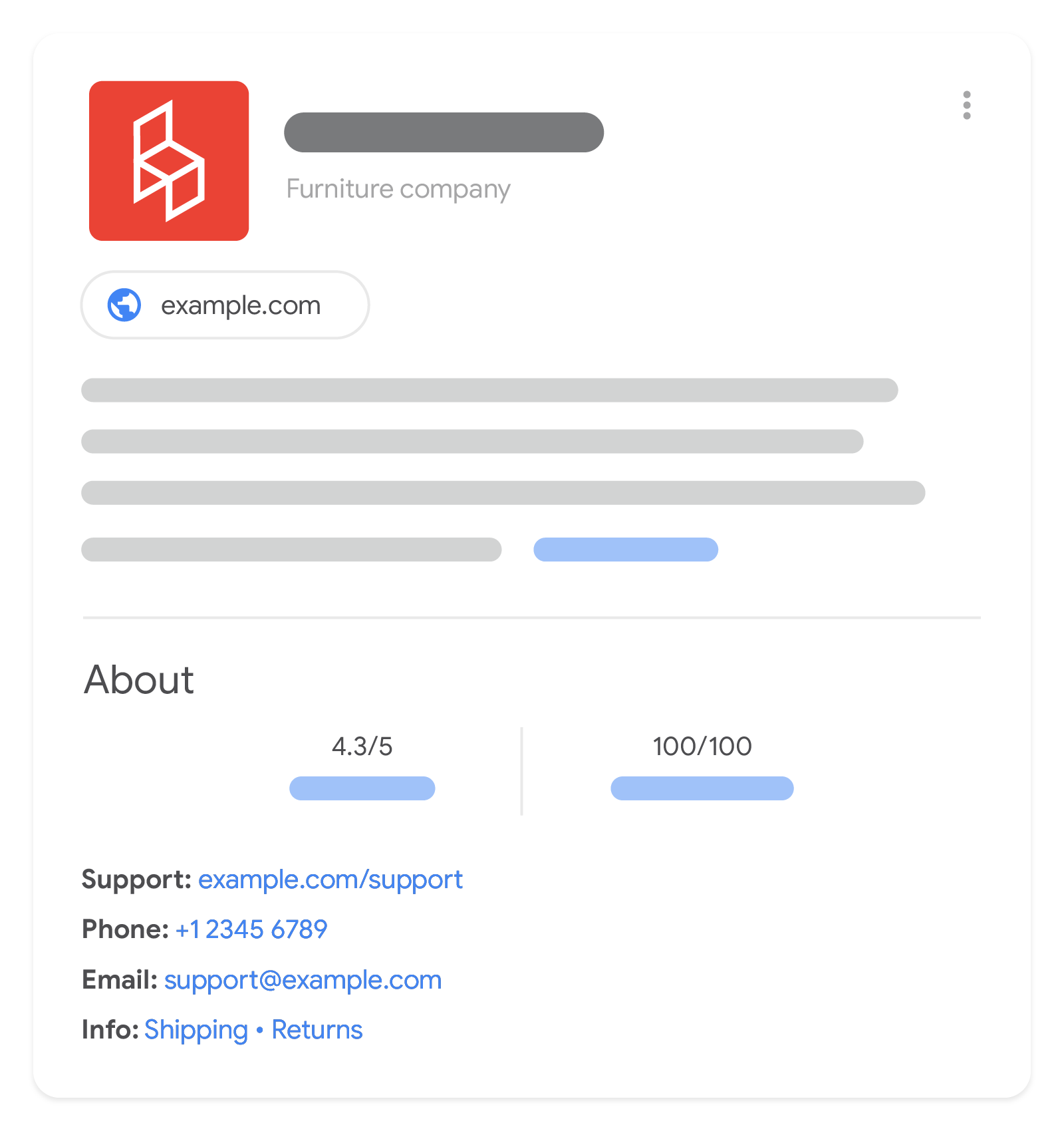组织 (Organization) 结构化数据

向首页添加组织结构化数据有助于 Google 更好地了解贵组织的管理详细信息,并在搜索结果中清晰地识别和区分贵组织。系统会在后台通过某些属性将贵组织与其他组织区分开来(例如 iso6523 和 naics),而其他属性则会影响搜索结果中的视觉元素(例如,在搜索结果和知识面板中显示哪个 logo)。
如果您是商家,则可以影响商家知识面板和品牌资料中的更多详细信息,例如退货政策、地址和联系信息。没有必需添加的属性,但我们建议您添加尽可能多的与贵组织相关的属性。
如何添加结构化数据
结构化数据是一种提供网页相关信息并对网页内容进行分类的标准化格式。如果您不熟悉结构化数据,可以详细了解结构化数据的运作方式。
下面概述了如何构建、测试和发布结构化数据。
- 添加尽可能多的适用于您网页的建议属性。没有必需添加的属性,根据您的内容按需添加即可。 根据您使用的格式,了解在网页上的什么位置插入结构化数据。
- 遵循指南。
- 使用富媒体搜索结果测试验证您的代码,并修复所有严重错误。此外,您还可以考虑修正该工具中可能会标记的任何非严重问题,因为这些这样有助于提升结构化数据的质量(不过,要使内容能够显示为富媒体搜索结果,并非必须这么做)。
- 部署一些包含您的结构化数据的网页,然后使用网址检查工具测试 Google 看到的网页样貌。请确保您的网页可供 Google 访问,不会因 robots.txt 文件、
noindex标记或登录要求而被屏蔽。如果网页看起来没有问题,您可以请求 Google 重新抓取您的网址。 - 为了让 Google 随时了解日后发生的更改,我们建议您提交站点地图。Search Console Sitemap API 可以帮助您自动执行此操作。
示例
Organization
下面是一个 JSON-LD 代码格式的组织信息示例。
<html>
<head>
<title>About Us</title>
<script type="application/ld+json">
{
"@context": "https://schema.org",
"@type": "Organization",
"url": "https://www.example.com",
"sameAs": ["https://example.net/profile/example1234", "https://example.org/example1234"],
"logo": "https://www.example.com/images/logo.png",
"name": "Example Corporation",
"description": "The example corporation is well-known for producing high-quality widgets",
"email": "contact@example.com",
"telephone": "+47-99-999-9999",
"address": {
"@type": "PostalAddress",
"streetAddress": "Rue Improbable 99",
"addressLocality": "Paris",
"addressCountry": "FR",
"addressRegion": "Ile-de-France",
"postalCode": "75001"
},
"vatID": "FR12345678901",
"iso6523Code": "0199:724500PMK2A2M1SQQ228"
}
</script>
</head>
<body>
</body>
</html>具有配送政策和退货政策的 OnlineStore(Organization 的子类型)
下面是一个具有 JSON-LD 代码格式的配送政策和退货政策的网店示例。
如需查看更多示例并详细了解商家级标准退货政策,请参阅单独的商家退货政策标记文档。
<html>
<head>
<title>About Us</title>
<script type="application/ld+json">
{
"@context": "https://schema.org",
"@type": "OnlineStore",
"name": "Example Online Store",
"url": "https://www.example.com",
"sameAs": ["https://example.net/profile/example12", "https://example.org/@example34"],
"logo": "https://www.example.com/assets/images/logo.png",
"contactPoint": {
"contactType": "Customer Service",
"email": "support@example.com",
"telephone": "+47-99-999-9900"
},
"vatID": "FR12345678901",
"iso6523Code": "0199:724500PMK2A2M1SQQ228",
"hasMerchantReturnPolicy": {
"@type": "MerchantReturnPolicy",
"applicableCountry": ["FR", "CH"],
"returnPolicyCountry": "FR",
"returnPolicyCategory": "https://schema.org/MerchantReturnFiniteReturnWindow",
"merchantReturnDays": 60,
"returnMethod": "https://schema.org/ReturnByMail",
"returnFees": "https://schema.org/FreeReturn",
"refundType": "https://schema.org/FullRefund"
}
// Other Organization-level properties
// ...
}
</script>
</head>
<body>
</body>
</html>指南
要使您的结构化数据能够显示在 Google 搜索结果中,您必须遵循以下指南。
技术指南
我们建议您将此信息放在首页或描述贵组织的单个页面中,例如“关于我们”页面。您无需在网站的每个网页中添加此标记。
我们建议您使用与贵组织相符的最具体 schema.org 子类型 Organization。例如,如果您拥有电子商务网站,我们建议您使用 OnlineStore 子类型,而不是 OnlineBusiness。如果您的网站是关于本地商家(例如餐厅或实体店),建议您使用最具体的 LocalBusiness 子类型提供组织管理详情;除了本指南中建议的字段外,也请遵守面向本地商家的必需和建议字段规定。
不同结构化数据类型的定义
Google 可识别 Organization 的以下属性。为了帮助 Google 更好地了解您的网页,请添加尽可能多的适用于该网页的建议属性。没有必需添加的属性,按需添加适用于贵组织的属性即可。
| 建议属性 | |
|---|---|
address |
贵组织的实际地址或邮寄地址(如果适用)。请添加适用于您所在国家/地区的所有属性。提供的属性越多,搜索结果对用户来说就质量越高。如果贵组织在多个城市、省级行政区或国家/地区都有分支地点,可以提供多个地址。 例如: "address": [{ "@type": "PostalAddress", "streetAddress": "999 W Example St Suite 99 Unit 9", "addressLocality": "New York", "addressRegion": "NY", "postalCode": "10019", "addressCountry": "US" },{ "streetAddress": "999 Rue due exemple", "addressLocality": "Paris", "postalCode": "75001", "addressCountry": "FR" }] |
address.addressCountry |
贵组织邮政地址所属的国家/地区,使用两个字母组成的 ISO 3166-1 alpha-2 国家/地区代码。 |
address.addressLocality |
贵组织邮政地址所属的城市。 |
address.addressRegion |
贵组织邮政地址所属的区域(如果适用)。例如,省级行政区。 |
address.postalCode |
贵组织所在地址的邮政编码。 |
address.streetAddress |
贵组织邮政地址的完整街道地址。 |
alternateName |
贵组织使用的另一个常用名称(如果适用)。 |
contactPoint |
用户联系贵商家的最佳方式(如果适用)。按照 Google 推荐的最佳实践添加用户可用的所有支持方法。例如: "contactPoint": { "@type": "ContactPoint", "telephone": "+9-999-999-9999", "email": "contact@example.com" } |
contactPoint.email |
用于联系贵商家的电子邮件地址(如果适用)。
如果您使用的是 |
contactPoint.telephone |
用于联系贵商家的电话号码(如果适用)。
请务必在电话号码中包含国家/地区代码和区号。
如果您使用的是 |
description |
对贵组织的详细说明(如果适用)。 |
duns |
用于标识您的 |
email
|
用于联系贵商家的电子邮件地址(如果适用)。 |
foundingDate |
贵 |
globalLocationNumber |
用于标识您的 |
hasMerchantReturnPolicy
|
您的 |
hasMemberProgram
|
您提供的会员(回馈)计划(如果适用)。
如需详细了解 |
hasShippingService
|
您的 |
iso6523Code
|
贵组织的 ISO 6523 标识符(如果适用)。
ISO 6523 标识符的第一部分是
|
legalName |
|
leiCode |
ISO 17442 中定义的 |
logo |
可代表贵组织的徽标(如果适用)。添加此属性有助于 Google 更好地了解您要显示哪个徽标,例如在搜索结果和知识面板中显示此徽标。 图片准则:
如果您使用 |
naics |
您 |
name |
您的组织的名称。请使用与网站名称相同的 |
numberOfEmployees |
贵 包含特定员工人数的示例: "numberOfEmployees": { "@type": "QuantitativeValue", "value": 2056 } 包含特定范围内员工人数的示例: "numberOfEmployees": { "@type": "QuantitativeValue", "minValue": 100, "maxValue": 999 } |
sameAs
|
另一网站中包含贵组织其他相关信息的网页的网址(如果适用)。例如,社交媒体或评价网站中的贵组织资料页面的网址。您可以提供多个 |
taxID
|
与您的 |
telephone
|
商家电话号码应该是面向客户的主要联系方式(如果适用)。 请务必在电话号码中包含国家/地区代码和区号。 |
url
|
贵组织的网站网址(如果适用)。这有助于 Google 唯一性识别您的组织。 |
vatID
|
与您的 |
问题排查
如果您在实施或调试结构化数据时遇到问题,请查看下面列出的一些实用资源。
- 如果您使用了内容管理系统 (CMS) 或其他人负责管理您的网站,请向其寻求帮助。请务必向其转发列明问题细节的任何 Search Console 消息。
- Google 不能保证使用结构化数据的功能一定会显示在搜索结果中。如需查看导致 Google 无法将您的内容显示为富媒体搜索结果的各种常见原因,请参阅结构化数据常规指南。
- 您的结构化数据可能存在错误。请参阅结构化数据错误列表。
- 如果您的网页受到结构化数据手动操作的影响,其中的结构化数据将会被忽略(但该网页仍可能会出现在 Google 搜索结果中)。如需修正结构化数据问题,请使用“人工处置措施”报告。
- 再次查看相关指南,确认您的内容是否未遵循指南。问题可能是因为出现垃圾内容或使用垃圾标记导致的。不过,问题可能不是语法问题,因此富媒体搜索结果测试无法识别这些问题。
- 针对富媒体搜索结果缺失/富媒体搜索结果总数下降进行问题排查。
- 请等待一段时间,以便 Google 重新抓取您的网页并重新将其编入索引。请注意,网页发布后,Google 可能需要几天时间才会找到和抓取该网页。有关抓取和索引编制的常见问题,请参阅 Google 搜索抓取和索引编制常见问题解答。
- 在 Google 搜索中心论坛中发帖提问。
